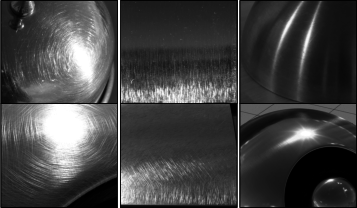Section: New Results
Analysis and Simulation
Principles of Light Field Imaging
Light field imaging offers powerful new capabilities through sophisticated digital processing techniques that are tightly merged with unconventional optical designs. This combination of imaging technology and computation necessitates a fundamentally different view of the optical properties of imaging systems and poses new challenges for the traditional signal and image processing domains. We aimed to provide a comprehensive review [14] of the considerations involved and the difficulties encountered in working with light field data during 25 years of research.
Physically-Based Reflectance Model Combining Reflection and Diffraction
Reflectance properties express how objects in a virtual scene interact with light; they control the appearance of the object: whether it looks shiny or not, whether it has a metallic or plastic appearance. Having a good reflectance model is essential for the production of photo-realistic pictures. Measured reflectance functions provide high realism at the expense of memory cost. Parametric models are compact, but finding the right parameters to approximate measured reflectance can be difficult. Most parametric models use a model of the surface micro-geometry to predict the reflectance at the macroscopic level. We have shown [26] that this micro-geometry causes two different physical phenomena: reflection and diffraction. Their relative importance is connected to the surface roughness. Taking both phenomena into account, we develop a new reflectance model that is compact, based on physical properties and provides a good approximation of measured reflectance.
Multi-Scale and Structured SV-BRDF Model for Scratched Materials
|
We developed a Spatially-Varying BRDF model tailored to the multi-scale rendering of scratched materials such as metals, plastics or finished woods. Our approach takes advantage of the regular structure of scratch distributions to achieve high performance without compromising visual quality (fig. 8). The BRDF for a single scratch is simulated using an optimized 2D ray-tracer and compactly stored in a three-component 2D texture. In contrast to existing models, our approach takes into account all inter-reflections inside a scratch, including Fresnel effects. At render time, the SV-BRDF for the scratch distribution under a pixel or ray footprint is obtained by linear combination of individual scratch BRDFs. Our model can be evaluated using both importance and light sampling, in direct and global illumination settings. Our approach provides users with controls over the profile, micro-BRDF, density and orientation of scratches. All these material properties are updated at interactive rates. This work has been published at ACM Siggraph 2016 [16] and one our result has been selected as the cover of the ACM Siggraph 2016 proceedings. It is part of the PhD Thesis "Control of anisotropic materials appearance" [11] defended this year.
Cues for Perception of Appearance
Thanks for the FP7 ITN PRISM, we have participated to several user studies to understand the perception of an object appearance. First, for fluids and other deformable materials, we find [25] that observers show a high degree of constancy in matching the viscosity across the different variations. However, volume differences between test and match stimulus, especially with static stimuli, caused large effects of over- and under-estimation of viscosity. We also find that a number of cues related to curvatures, periodic movements of the liquids, and the way they spread out predict aspects of the observer’s performance, but that humans achieve better constancy than the cues predict.
We have also investigated gloss haze [22]. The results reveals that haziness is a distinct visual dimension orthogonal to the commonly studied glossiness and blurriness. Coatedness appears to be nearly synonymous with haziness, as this is one of the main physical causes of haze in real world materials. Polish seems to be a combination of glossiness and haziness, as materials go from dull to hazy to highly glossy during the physical polishing process. The inferred tactile quality of friction is apparently uncorrelated with haziness. Our results demonstrate that haze is indeed a distinct perceptual dimension of gloss, which is systematically related to the kurtosis of the specular lobe.



